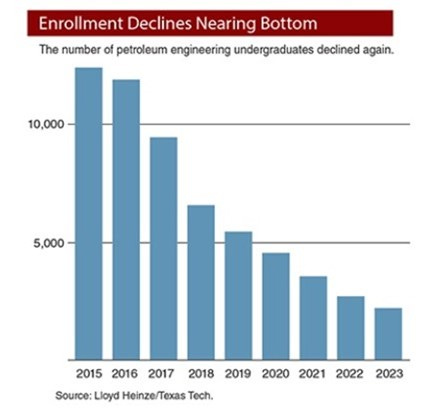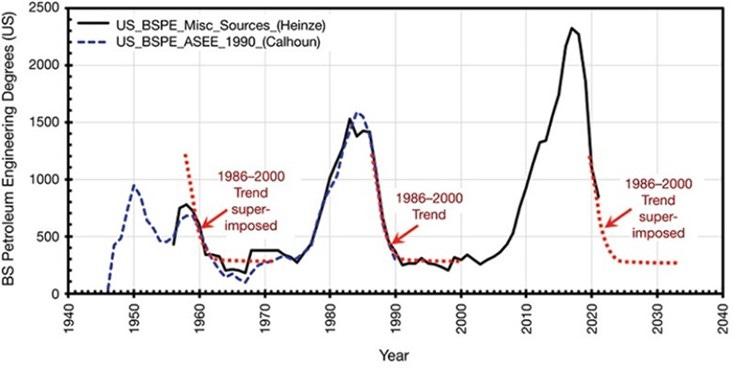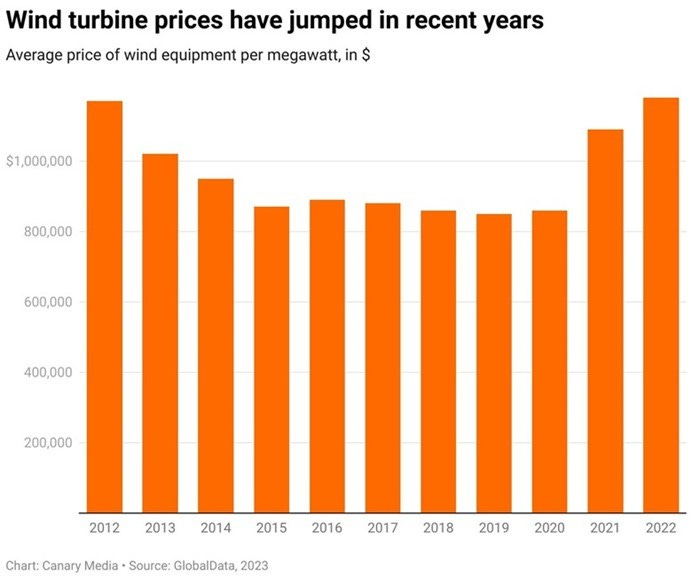Energy Musings - June 15, 2023
The energy transition is encountering more hurdles which have been overlooked in the push for a rapid and smooth transition. Overcoming these hurdles will take time and boost future costs.
Energy Transition Not Going As Smoothly As Expected
The yellow haze that descended on East Coast cities last week sent environmental activists into overdrive claiming the smoke from eastern Canadian wildfires was proof of climate change. Wildfires are caused by fossil fuels and burning them needs to end immediately they claimed, ignoring weak forest management issues. Residents west of the Mississippi River might laugh at the claims that wildfires create unacceptable smoke. Those Western U.S. residents have been living with wildfire smoke for years, but now that smoke is in the East, it is a national emergency.
Canadian wildfire smoke envelopes New York City and alarms residents on the East Coast.
Getty Images
At the heart of the climate change movement is the belief we must transition the globe’s energy system to save the planet. It means abandoning fossil fuels and powering our economies with only “green” energy – primarily wind, solar, and hydrogen. While there are other green energy sources, they are geographically limited and often involve agriculture, another greenhouse gas-producing industry.
The energy transition is embraced by politicians worldwide who are acting on this belief, but primarily in developed economies. Leaders of these countries are willing to sacrifice their citizens’ standards of living for clean energy. This is a sore point for developing economies which are told to transition before they have reached developed economies’ standards of living, capping economic improvement.
Wind and solar are preferred in the energy transition push. Their fuels are free, and the technologies seem simple. They are considered the cleanest of all the green fuel options. However, to power grids, these part-time energy sources require backup power – more expensive and producing more carbon emissions – and subject to increasing blackouts. We know the wind does not always blow and the sun does not always shine. During those times, consumers need other energy sources to generate their electricity. Thus, the cleanest green energy fuels are hurting family budgets.
While ignoring the debate over policy issues, we need to acknowledge that the policies in place are forcing industries to alter their products and how they manufacture them, all to ensure they are helping the green energy transition. Whether it is electric vehicles (EV), gas-powered stoves and furnaces, heat pumps, rooftop solar systems, or sustainable fuels, industries are remaking their output. While getting ahead of new consumer trends is a smart business model, most of these shifts are in response to government greenhouse gas emissions mandates and hefty taxpayer subsidies to make the more expensive products cheaper. Many of these changes are not popular with the public, complicating the reality businesses must navigate.
Recently, the strategy to “electrify everything” in today’s modern economy, allowing it to be powered by green energy, has run into a problem - inadequate transmission systems. The Department of Energy (DoE), in a May 10, 2022, press release about the need to add grid capacity stated:
“Independent estimates indicate that we need to expand electricity transmission systems by 60% by 2030 and may need to triple it by 2050 to meet the country’s increase in renewable generation and expanding electrification needs.”
Quantifying the needed expansion is a challenge. According to various estimates, there are anywhere from 240,000 to 642,000 miles of high-voltage transmission lines crisscrossing the U.S. The high estimate comes from a 2020 DoE report ‒ “Advanced Transmission Technologies” ‒ that explored the green energy transition challenge. Even using the low mileage estimate, meeting the 2030 expansion goal means constructing 144,000 miles of new transmission lines.
An analysis by C Three Group, a consulting firm focused on North American infrastructure, said that between 2008 and 2021 the U.S. high-voltage transmission system grew by about 1,700 miles per year. Another estimate for 2019-2022 shows an average of 1,400 miles of transmission lines added annually to the grid. At these rates, it will take 85-102 years to expand the grid by 60%. Think how many years it will take to double the grid!
There are similar problems with the national grids of European Union member countries. While the number of new transmission miles needed is considerably smaller than in the U.S., the critical nature of the expansion needs is similar.
While the scope of transmission expansions is daunting, making progress will require obtaining permits allowing the building of the new lines, securing the necessary components, and finding sufficient construction and electrical workers. The magnitude of these challenges is being ignored by green energy transition promoters.
What else has been overlooked in the green energy transition? Let’s see. The list begins with critical and rare earth minerals supplies, electricity system components (transformers, substations, etc.), and all the trained labor necessary for building and operating the new green energy infrastructure. We could add other issues such as having enough offshore wind installation vessels, solutions to the offshore wind radar interference problem, sufficient EV charging stations, the specialty steel needed for building the new generation electricity transformers mandated by regulators, and replacing gas-powered stoves and furnaces.
The worker situation may become a serious impediment to the pace of the energy transition, as well as its cost. The worker shortage is caused by the aging of our existing workforce, the time needed to educate and train new workers, and importantly, the rejection of these critical industries by youths seeking employment.
An emerging hurdle is the banning of mining and oil and gas companies from recruiting on university campuses, a phenomenon that has started in Europe. Four major universities in the U.K. have instituted such bans. We will not be surprised to see this movement spread to other universities in England and across Europe.
The cyclical nature of commodity industries has always produced booms and busts in university enrollments for technical degree programs necessary for producing the new workers needed to continue and grow these industries. The following two charts show the recent trend in petroleum engineering undergraduates worldwide and the long-term history of petroleum engineering enrollments.
The professor who tracks petroleum degree enrollment is optimistic the cycle is turning to bring more students. Climate activists are hoping he is wrong.
The long-term petroleum degree enrollment trend does not offer much hope for an improvement in the supply of trained labor.
The next chart shows for 2011-2021 the number of U.S. students graduating with degrees in geology and earth sciences. The 2021 graduation total shows a return to the level of a decade earlier, confirming the problem employers will face with a smaller pool of newly trained workers for the mining and petroleum industries.
Mining and petroleum industries are facing skilled labor challenges as current workers retire.
The following chart from a McKinsey study highlights the attitudes of 13-30-year-olds toward working in the mining and petroleum industries. Those two industries rank as the least attractive for this younger population segment. Not positive for these industries.
Today’s youth, the core of our future workforce, are rejecting working in the mining and petroleum industries which will be critical for meeting the world’s future energy needs.
Despite the push to eliminate oil and gas, all the industry forecasts foresee these fuels playing a significant role in the world’s energy supply mix for decades to come. For mining, which is ranked as the least attractive industry for employment, its role in facilitating the energy transition is critical. Without sufficient technical employees, developing the mines and processing plants needed to facilitate the energy transition will not happen on the timeline assumed. As a result, the cost of getting the needed minerals will rise as higher wages will be required to attract the limited number of trained workers.
This lack of talent is a hidden hurdle for the energy transition. Currently, clean energy CEOs cite inflation, supply chain issues, and higher interest rates as the forces disrupting the industry’s trajectory. These problems are inflating costs and crippling project economics. Two studies – Wood Group and Global Data – show the impact of inflation and supply chain issues on the cost of offshore wind projects. The Wood Group claims inflation in equipment and labor costs have boosted project costs by 20%, while Global Data says that for 2020-2022, wind turbine costs have increased by 38%. Projections are these costs will increase further in 2023.
Soaring wind turbine prices, which account for half the cost of a wind farm, are upsetting developer economics.
The inflation and supply chain issues are raising renewable project costs. Those cost pressures are supplemented by higher interest rates that are raising the cost of capital for these projects. All the issues we listed as being overlooked by those pushing for a rapid energy transition will increase project costs. The labor shortage challenge may become one of the major cost and timing impediments to a rapid and smooth energy transition. The public deserves a better assessment of what these problems will do to future electricity prices so they are prepared and can adjust. Or maybe they will call for a timeout and reassessment of the pace of the green energy transition.









